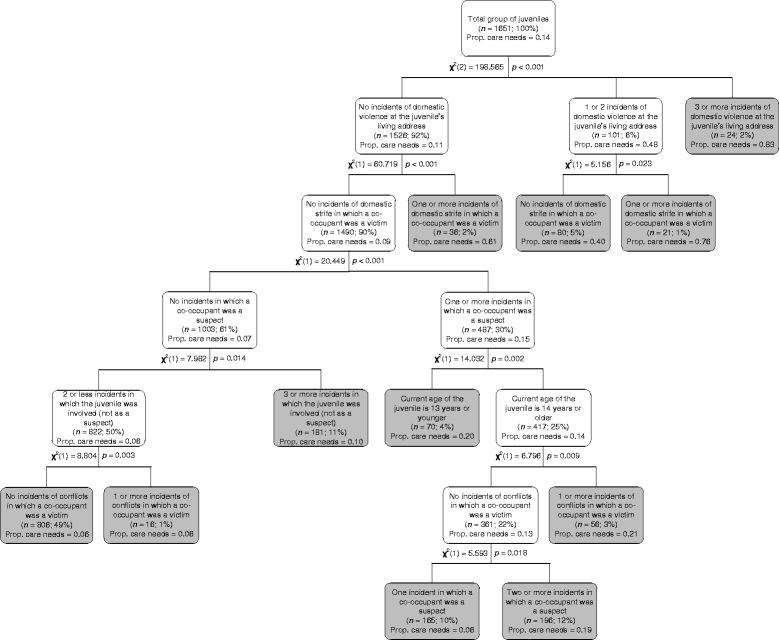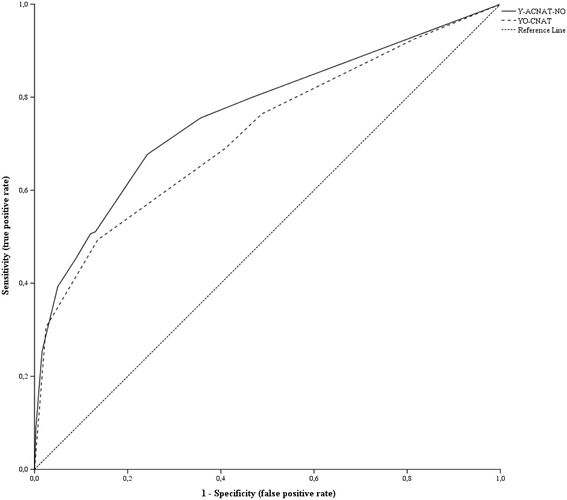The development and validation of the Youth Actuarial Care Needs Assessment Tool for Non-Offenders (Y-ACNAT-NO)
- PMID: 25885909
- PMCID: PMC4399228
- DOI: 10.1186/s12888-015-0421-1
The development and validation of the Youth Actuarial Care Needs Assessment Tool for Non-Offenders (Y-ACNAT-NO)
Abstract
Background: In The Netherlands, police officers not only come into contact with juvenile offenders, but also with a large number of juveniles who were involved in a criminal offense, but not in the role of a suspect (i.e., juvenile non-offenders). Until now, no valid and reliable instrument was available that can be used by Dutch police officers for estimating the risk for future care needs of juvenile non-offenders. In the present study, the Youth Actuarial Care Needs Assessment Tool for Non-Offenders (Y-ACNAT-NO) was developed for predicting the risk for future care needs that consisted of (1) a future supervision order as imposed by a juvenile court judge and (2) future worrisome incidents involving child abuse, domestic violence/strife, and/or sexual offensive behavior at the juvenile's living address (i.e., problems in the child-rearing environment).
Methods: Police records of 3,200 juveniles were retrieved from the Dutch police registration system after which the sample was randomly split in a construction (n = 1,549) and validation sample (n = 1,651). The Y-ACNAT-NO was developed by performing an Exhaustive CHAID analysis using the construction sample. The predictive validity of the instrument was examined in the validation sample by calculating several performance indicators that assess discrimination and calibration.
Results: The CHAID output yielded an instrument that consisted of six variables and eleven different risk groups. The risk for future care needs ranged from 0.06 in the lowest risk group to 0.83 in the highest risk group. The AUC value in the validation sample was .764 (95% CI [.743, .784]) and Sander's calibration score indicated an average assessment error of 3.74% in risk estimates per risk category.
Conclusions: The Y-ACNAT-NO is the first instrument that can be used by Dutch police officers for estimating the risk for future care needs of juvenile non-offenders. The predictive validity of the Y-ACNAT-NO in terms of discrimination and calibration was sufficient to justify its use as an initial screening instrument when a decision is needed about referring a juvenile for further assessment of care needs.
Figures


Similar articles
-
Youth Offender Care Needs Assessment Tool (YO-CNAT): an actuarial risk assessment tool for predicting problematic child-rearing situations in juvenile offenders on the basis of police records.Psychol Assess. 2013 Dec;25(4):1167-78. doi: 10.1037/a0033453. Epub 2013 Jul 1. Psychol Assess. 2013. PMID: 23815118
-
Youth Actuarial Risk Assessment Tool (Y-ARAT): The development of an actuarial risk assessment instrument for predicting general offense recidivism on the basis of police records.Assessment. 2014 Jun;21(3):340-51. doi: 10.1177/1073191113495710. Epub 2013 Jul 9. Assessment. 2014. PMID: 23838639
-
The Development and Validation of an Actuarial Risk Assessment Tool for the Prediction of First-Time Offending.Int J Offender Ther Comp Criminol. 2016 May;60(7):847-64. doi: 10.1177/0306624X14558204. Epub 2014 Nov 12. Int J Offender Ther Comp Criminol. 2016. PMID: 25395478
-
Forensic aspects of juvenile violence.Child Adolesc Psychiatr Clin N Am. 2000 Oct;9(4):859-81. Child Adolesc Psychiatr Clin N Am. 2000. PMID: 11005010 Review.
-
Juvenile Sex Offenders.Curr Psychiatry Rep. 2016 Jul;18(7):67. doi: 10.1007/s11920-016-0706-1. Curr Psychiatry Rep. 2016. PMID: 27222141 Review.
Cited by
-
Why Are Child and Youth Welfare Support Services Initiated? A First-Time Analysis of Administrative Data on Child and Youth Welfare Services in Austria.Children (Basel). 2023 Aug 11;10(8):1376. doi: 10.3390/children10081376. Children (Basel). 2023. PMID: 37628375 Free PMC article.
References
-
- Harbert A, Tucker-Tatlow J. Review of child welfare risk assessments [http://theacademy.sdsu.edu/programs/SACHS/literature/SACHS_Risk_Assessme...]
-
- Doueck HJ, English DJ, DePanfilis D, Moore GT. Decisionmaking in child protective services: a comparison of selected risk-assessment systems. Child Welfare. 1993;72:441–53. - PubMed
-
- Bender K. Why do some maltreated youth become juvenile offenders? a call for further investigation and adaptation of youth services. Child Youth Serv Rev. 2010;32:466–73. doi: 10.1016/j.childyouth.2009.10.022. - DOI
Publication types
MeSH terms
LinkOut - more resources
Full Text Sources
Other Literature Sources

